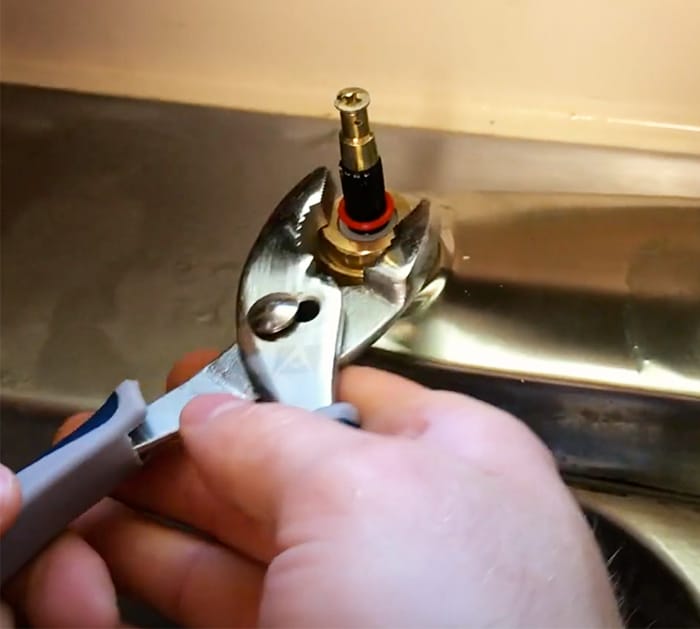What're your concepts on Why Are My Faucets Dripping (And Can I Fix It Myself)??

Dripping taps may look like a small inconvenience, yet their impact surpasses just the aggravation of the sound. From drainage to sustaining unneeded financial expenses and wellness risks, disregarding a leaking tap can cause various repercussions. In this write-up, we'll delve into why it's vital to resolve this usual house concern immediately and efficiently.
Wastefulness of Water
Ecological Effect
Trickling faucets contribute considerably to water waste. According to the Epa (EPA), a solitary tap trickling at one drip per secondly can waste more than 3,000 gallons of water annually. This not just stress water resources but also influences communities and wild animals based on them.
Step-by-Step Overview to Dealing With a Dripping Faucet
Devices Needed
Before trying to take care of a trickling faucet, gather the necessary devices, consisting of an adjustable wrench, screwdrivers, replacement components (such as washers or cartridges), and plumber's tape.
Common Faucet Issues and Their Solutions
Determine the sort of tap and the particular concern triggering the drip. Typical troubles consist of damaged washers, corroded shutoff seats, or damaged O-rings. Refer to supplier guidelines or on-line tutorials for step-by-step support on repair work.
Financial Prices
Raised Water Costs
Beyond the environmental effect, dripping faucets can inflate water costs considerably. The built up wastage gradually translates right into greater utility costs, which could have been prevented with prompt repairs.
Potential Residential Property Damage
Additionally, long term dripping can cause harm to fixtures and surface areas bordering the faucet. Water accumulation can trigger staining, rust, and also architectural problems if left unattended, resulting in extra repair work costs.
Health Worries
Mold And Mildew and Mold Development
The continuous existence of moisture from a trickling faucet produces a suitable setting for mold and mildew and mildew development. These fungis not only endanger interior air high quality however additionally present wellness risks, especially for individuals with respiratory problems or allergies.
Waterborne Illness
Stationary water in trickling taps can end up being a breeding place for microorganisms and various other virus, raising the threat of waterborne diseases. Impurities such as Legionella bacteria prosper in stagnant water, potentially resulting in major illnesses when ingested or breathed in.
DIY vs. Expert Fixing
Advantages and disadvantages of DIY Repair Work
While some might try to take care of a leaking tap themselves, do it yourself fixings come with their very own set of challenges. Without correct expertise and tools, DIY efforts can intensify the issue or lead to insufficient fixings, lengthening the problem.
Advantages of Working With a Specialist Plumber
Hiring a specialist plumber guarantees that the underlying root cause of the dripping faucet is resolved properly. Plumbing technicians have the knowledge and tools to identify and repair tap issues efficiently, conserving time and reducing the threat of more damages.
Environmental Responsibility
Individual Payment to Conservation
Taking obligation for taking care of trickling taps straightens with more comprehensive efforts towards water conservation and ecological sustainability. Every individual's actions collectively make a substantial impact on maintaining valuable sources.
Lasting Living Practices
By prioritizing timely repairs and taking on water-saving habits, individuals add to lasting living methods that profit both existing and future generations.
Safety nets
Regular Maintenance Tips
To avoid leaking faucets, execute regular upkeep such as cleaning up aerators, checking for leaks, and changing worn-out parts promptly. Additionally, consider setting up water-saving gadgets or updating to a lot more effective fixtures.
Relevance of Prompt Repairs
Addressing trickling faucets as quickly as they're seen stops further water waste and possible damages, inevitably conserving both water and money in the future.
Effect On Property Value
Assumption of Well-Maintained Residential Or Commercial Property
Maintaining a home in good condition, including addressing maintenance issues like trickling faucets, enhances its viewed value and desirability amongst potential customers or renters.
Impact on Resale Value
Characteristics with well-kept plumbing components, consisting of faucets, command higher resale worths in the real estate market. Attending to trickling faucets can contribute to a favorable impression throughout property assessments and arrangements.
Conclusion
Attending to a trickling tap goes beyond mere benefit; it's an essential step toward saving water, minimizing financial expenses, and safeguarding wellness and building. Whether with do it yourself repairs or professional aid, taking action to deal with dripping faucets is a little yet impactful method to promote accountable stewardship of sources and add to a healthier, more lasting future.
How to Fix a Dripping or Leaky Faucet
A leaking faucet is one of the most common problems that homeowners encounter, but it being commonplace doesn’t make it any less annoying. The constant drip drip drip of a leaking bathtub faucet, showerhead, or sink tap can disturb your home’s serenity. Left neglected, a dripping faucet can also result in higher water bills and discoloration or mold growth in your sink or plumbing fixtures.
Fortunately, you don’t have to be a trained plumber to know how to stop a dripping faucet. With some basic tools, replacement parts, and a little patience, leaky faucet repair is a breeze. In this article, we’ll explain what causes dripping faucets and how you can fix them.
What Causes a Leaking Faucet?
Kitchen and bathroom faucets come in all manner of designs, but most involve some combination of valves, O-rings, seals, and washers. The O-ring is usually the weakest link, but any one of these pieces can wear down over time. Heat, moisture, temperature fluctuations, minerals, mold, and movement can contribute to warping and corrosion, breaking the watertight seal. This just comes with the territory of being a homeowner. Everything is always subject to wear and tear, and some component parts of your appliances and fixtures need to be replaced on occasion. At least replacement O-rings are cheap!
More rarely, dripping faucets can be a symptom of excessively high water pressure. Were this the case in your home, you would probably notice that the leak is not isolated to one faucet. Water pressure issues are harder to resolve on your own. We recommend contacting a professional plumber if you suspect your water pressure is too high.
How to Fix a Dripping Faucet
Pipe wrench or monkey wrench Allen wrench set Screwdrivers Old towel or rag Shut off the water.
Before you do anything, you need to turn off the water to keep from drenching your kitchen or bathroom. You should find a valve under the sink and against the wall. Once you’ve turned this valve, try turning the faucet on to confirm that the water source has been cut off.
If you can’t locate your local valve for the faucet you’re working on, you can always shut off the water to the house at the main valve. Of course, this will prohibit anyone from using the sinks, showers, or toilets while you’re working on the faucet that’s giving you trouble.
Plug or block the drain.
You’ll be disassembling the faucet and removing some small bits of hardware. Plug the drain with a stopper or rag to avoid the possibility of a small screw falling into your P-trap.
Take apart the faucet assembly.
There are several varieties of kitchen and bathroom faucets, each with its own manner of assembly. For detailed instructions on how to disassemble your faucet, you can refer to the fixture’s manual or contact the manufacturer. If you know whether you have a ball, disc, cartridge, or compression faucet, you can find detailed schematics online.
In general, you need to begin by removing the faucet handles. You might notice a small screw that you’ll need to remove with a screwdriver or Allen wrench. If you don’t see any visible securing hardware, it’s likely hidden under a decorative cap that can be unscrewed or popped off with flathead screwdriver.
Remove each piece methodically, consulting a schematic when necessary. Take notes or arrange the pieces in such a way to make it easier to correctly reassemble the faucet later.
Remove the cartridge.
Once you’ve removed the handles and securing hardware, you should be able to remove the valve cartridge or stem. Some cartridges will slide right out. Other faucet models will require you to loosen a nut with a pipe wrench before you can remove the valve stem.
Examine the exposed hardware.
With the cartridge or stem removed, inspect the component parts. Check the rubber O-rings for wear and tear. Also examine the seat washer for corrosion or other damage. These pieces are usually the responsible parties for a dripping faucet, but it’s worth inspecting the other component parts while you have the faucet disassembled.
Find replacement parts.
Once you’ve identified which faucet component has failed, find an identical replacement. Your local hardware store should have O-rings, seat washers, and other standard components in stock. If you have a luxury or uncommon faucet, you may have to contact the manufacturer for a replacement part.
It’s a good idea to take your old parts with you to the hardware store so you can compare them with the store’s inventory and be sure you’re purchasing the correct replacement.
Reassemble the faucet.
With your new parts in hand, reconstruct the faucet and handles. Don’t be tempted to overtighten screws or nuts. You might think this could create a better seal, but it can instead damage or bend a delicate part of the assembly and create a new problem for you.
Turn on the water and test the faucet.
The only thing left to do is test your work. Unplug the sink, turn the water back on, and try the faucet. Congratulate yourself on a job well done!
https://www.libertyhomeguard.com/how-to-fix-a-dripping-or-leaky-faucet/
Do you like reading up on How to Fix a Dripping or Leaky Faucet ? Try to leave a review down below. We'd be pleased to hear your feelings about this entry. In hopes that you visit us again in the near future. For those who liked our blog posting please be sure to pass it around. Thanks for being here. Kindly come visit our blog back soon.
 Danny Tamberelli Then & Now!
Danny Tamberelli Then & Now! Josh Saviano Then & Now!
Josh Saviano Then & Now! Danica McKellar Then & Now!
Danica McKellar Then & Now! Nancy Kerrigan Then & Now!
Nancy Kerrigan Then & Now! Heather Locklear Then & Now!
Heather Locklear Then & Now!